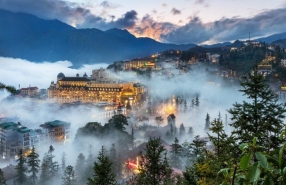Discover The Most Iconic Temples Of Angkor Wat Siem Reap

Exploring the Angkor complex is a journey into the ancient world of the Khmer Empire, where legendary temples have stood for centuries. Whether you plan to visit Angkor Wat in one day or join longer trips to Angkor Wat, preparation is essential to fully experience the beauty of the remarkable temples in Angkor. With its vast size and hundreds of temples scattered throughout the jungle, seeing the entire complex in one trip is nearly impossible. That’s why we guide you through the most iconic temples of Angkor Wat to help you discover the very best of this sacred site.
Which are the most iconic Angkor Wat temples?
I. Overview of the Angkor complex
The Angkor complex in Siem Reap, Cambodia, is one of the world’s most significant cultural heritage sites, attracting millions of visitors every year. Recognized as a UNESCO World Heritage Site, Angkor is the largest religious monument ever built, featuring hundreds of ancient temples spread across more than 400 km². With its exquisite Khmer architecture, the site is a must-visit for anyone wishing to visit Angkor Wat or seeking unique cultural experiences in Southeast Asia.

When joining trips to Angkor Wat, travelers can explore monumental structures such as the majestic Angkor Wat, the mysterious stone faces of Bayon, and the giant tree roots enveloping Ta Prohm. Each temple within the Angkor Wat temples complex carries its own story, architectural style, and spiritual meaning.
Beyond visiting the main temples in Angkor, travelers can enjoy memorable activities such as watching the sunrise at Angkor Wat, hiking through the forest to remote northern temples, or taking guided heritage tours with knowledgeable local experts. With hundreds of temples across the site, choosing the highlights is essential. For the most fulfilling Angkor Wat tour, whether short or long, we’ve selected the must-see temples you should not miss.
II. The most iconic Angkor Wat temples
1. Angkor Wat
Angkor Wat is the largest and most famous among all temples in Angkor, and it stands as the national symbol of Cambodia. Built in the 12th century under King Suryavarman II, the temple was originally dedicated to Vishnu before becoming a major Buddhist center. Its three-tiered layout, wide moat, and five towers symbolize Mount Meru - the “center of the universe” in Hindu cosmology.
When you visit Angkor Wat, the stunning Apsara carvings, long sandstone galleries, and magical sunrise views from the eastern side will leave you in awe. Angkor Wat is the highlight of every Angkor Wat temple tour, thanks to its architectural perfection, refined bas-reliefs, and deep spiritual value.

One of the most memorable things to do in Angkor Wat is watching the sunrise or sunset over the central towers. Capturing the sun rising behind the iconic silhouette or the reflection of the towers on the lotus pond is a dream for photographers worldwide. Visitors can also admire Ramayana reliefs or climb to the Bakan for a panoramic view. With its grandeur and timeless beauty, Angkor Wat is truly the soul of the entire Angkor complex.
2. Bayon Temple
Located at the heart of Angkor Thom, Bayon is one of the most impressive Angkor Wat temples, known for its hundreds of giant stone faces gazing in four directions. Built during the reign of King Jayavarman VII, the temple showcases a unique architectural style that blends mysticism with the symbolic power of Khmer art.

Famous for its 54 towers, each decorated with two to four serene faces believed to represent Bodhisattva Lokesvara or the king himself, Bayon is a must-see on most trips to Angkor Wat. It is especially appealing to those who appreciate mysterious atmospheres and intricate stone carvings. Don’t miss exploring the bas-reliefs depicting daily life of the ancient Khmer people or observing the iconic “smiling faces” from different angles, one of the top things to do in Angkor Wat.
You may also like:
>>> Angkor Temples tour itinerary 3 day 2 nights
>>> Angkor Temples tour itinerary 1 day
>>> 3-day Siem Reap trip
3. Ta Prohm
Ta Prohm is one of the most iconic temples in Angkor, famous for its “jungle-embraced ruins,” where massive trees twist around the stone walls, creating a wild and mystical atmosphere. The temple gained worldwide recognition after appearing in the Tomb Raider movie, making it one of the most beloved sites in the entire Angkor temple complex.
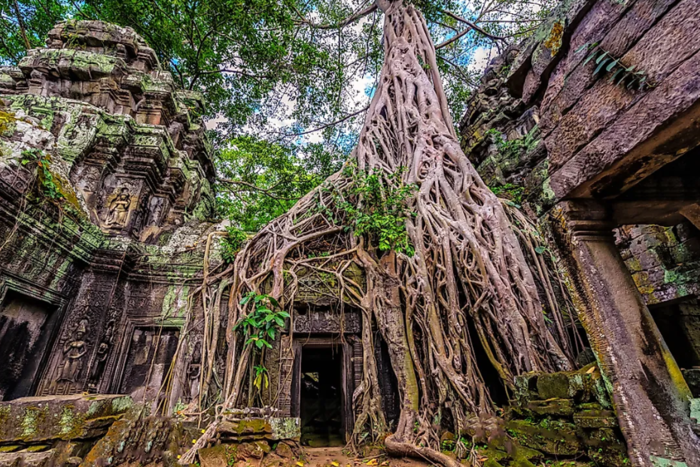
Unlike many restored temples, Ta Prohm has been preserved almost in its original condition, maintaining the feeling of an “Angkor lost in the jungle.” During your visit to Angkor Wat, this temple is always a top priority thanks to its dramatic visual appeal, especially when sunlight filters through the roots and foliage.
On your Angkor Wat temple tour, don’t miss the signature photo spots such as the massive Spung Tree roots wrapped around the entrance, the collapsed corridors, or the statues covered in moss. Ta Prohm offers a sacred, mysterious ambiance and stands as a living testament to the harmony between nature and ancient history.
4. Ta Som
Ta Som is a smaller temple within the Angkor Wat complex, yet it is incredibly captivating thanks to its peaceful atmosphere and fewer crowds compared to more famous sites. Built in the late 12th century by King Jayavarman VII to honor his father, Ta Som follows the Bayon style, featuring carved stone faces and beautifully designed gopura gates.
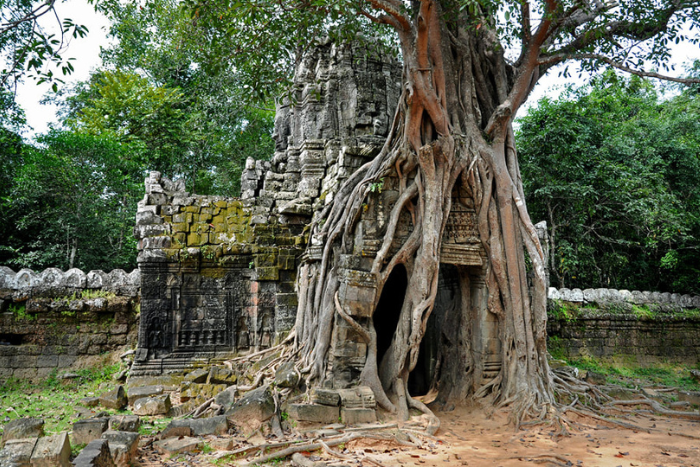
Its most iconic feature is the eastern gate, where a huge tree grows directly through the stone structure, creating one of the most photogenic scenes in the temples of Angkor Wat. For travelers seeking relaxing things to do in Angkor Wat, a gentle walk around Ta Som to admire the worn-down architecture, solemn statues, and moss-covered stones is a perfect choice. Despite its modest size, Ta Som showcases impressive artistic value and highlights the refined beauty of Khmer architecture.
5. Preah Khan
Preah Khan, meaning "holy sword,” is one of the largest temples in Angkor and once served as an important administrative and religious center under King Jayavarman VII. This vast complex features hundreds of chambers, long corridors, and exquisitely carved structures. Preah Khan feels like a “city in the forest,” where nature envelopes the ruins while many architectural details remain remarkably intact.
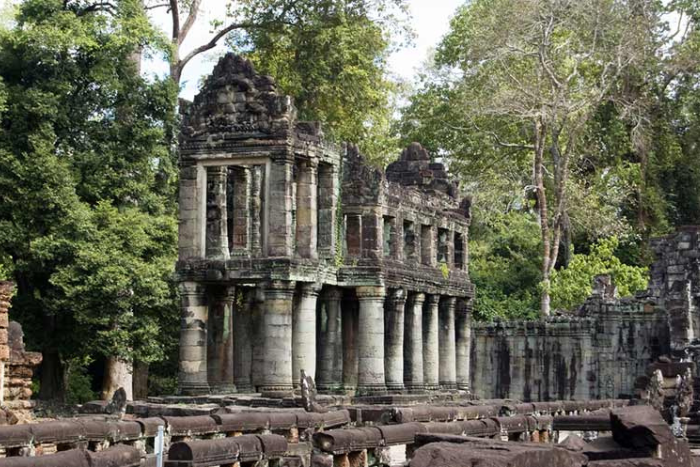
During an Angkor Wat temple tour, Preah Khan is definitely an ideal stop for travelers who enjoy deeper exploration and wandering through atmospheric narrow pathways. The blend of tree roots, stone walls, and soft light creates a mystical atmosphere without the heavy crowds seen at Ta Prohm. Beyond its mix of Buddhist and Hindu architecture, Preah Khan showcases detailed carvings of musicians, dancers, and deities. It is also one of the best places to witness the religious transition within the Khmer Empire.
6. Banteay Srei
Banteay Srei, often called the “pink jewel of Angkor”, is renowned for its rose-colored sandstone and some of the finest carvings in all Angkor Wat temples. Built in the 10th century, it is considered a masterpiece of early Khmer art. Its intricate bas-reliefs, sharp and delicate like “women’s craftsmanship,” reveal a refinement rarely found in other temples of Angkor. Scenes from Hindu mythology, including the Ramayana, are carved with exceptional clarity, making the temple an open-air museum of stone artistry.
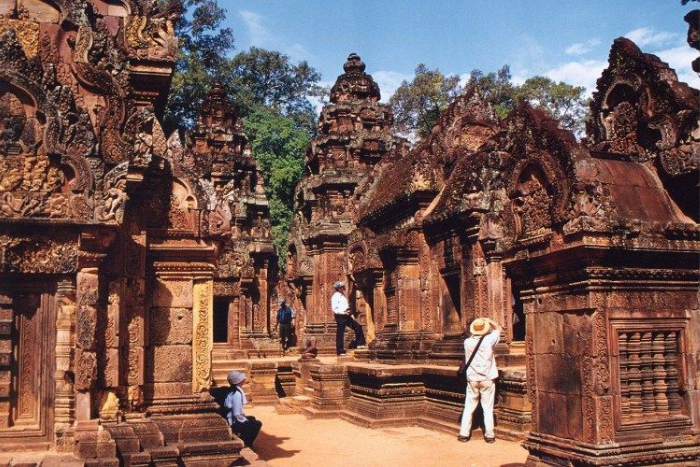
Many travelers include Banteay Srei in their things to do in Angkor Wat list, whether for admiring its ancient art, photographing its unique pink architecture, or combining the visit with nearby handicraft villages. With its timeless elegance and artistic precision, Banteay Srei stands as a true symbol of Khmer artistic excellence and is undeniably a must-see on any trips to Angkor Wat.
III. Tips for exploring the Angkor complex
To fully enjoy your journey through the Angkor Wat temples, start your visit early to avoid the heat and large crowds, especially at Angkor Wat and Bayon. If possible, purchase your ticket the afternoon before to save waiting time. When you visit Angkor Wat, remember that modest clothing covering shoulders and knees is required for sacred areas, so prepare appropriate outfits.
Consider joining an Angkor Wat temple tour with a local guide to better understand the history, symbolism, and stories behind each temple. For independent travelers, renting a bicycle or tuk-tuk, the most common transport method for trips to Angkor Wat, offers flexibility. Don’t forget water, sunscreen, a hat, and comfortable walking shoes, as you will be on the move all day.
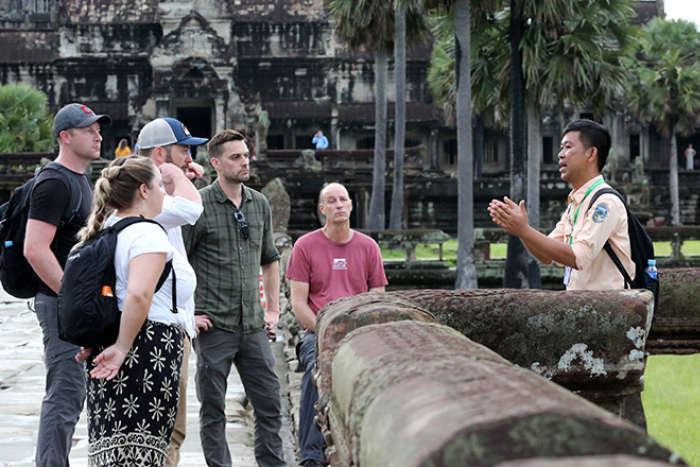
For those looking for unique things to do in Angkor Wat, try watching the sunrise at the main temple, visiting remote temples like Banteay Srei, or walking through the forest around Preah Khan. Planning your itinerary, prioritizing major highlights, and allowing time for quieter temples will ensure a fulfilling and memorable experience.
The Angkor complex gathers the greatest architectural and historical masterpieces of the Khmer civilization, offering an unforgettable journey for every traveler. Whether you plan to explore the temples in Angkor in one day or dive deeper with extended trips to Angkor Wat, each temple reveals its own captivating story. Prepare your schedule well, choose the right timing, and prioritize iconic sites such as Angkor Wat, Bayon, and Ta Prohm to make your visit to Angkor Wat perfect. To make your journey of exploring Angkor truly complete and as convenient as possible, you can travel with Autour Asia, a reputable travel agency in Cambodia that is always ready to bring you the most impressive cultural and relaxing experiences.
You can refer to:
>>> 7-day tour to Siem Reap Preah Vihear
>>> Cambodia Travel Guide
>>> 2 weeks Vietnam and Cambodia itinerary
>>> Cambodia itinerary 15 days
>>> Cambodia Packages Tours
The ideal time to visit the entire Angkor complex is from November to February, when the weather is coolest and most pleasant. This is the dry season, with little rain, making it perfect for moving between temples and taking photos. However, it is also peak tourist season, so booking early is recommended. If you prefer fewer crowds, consider traveling in March or July–September.
If you have enough time, you can consider the Angkor temples itinerary 4 days to fully explore the area, including Angkor Wat, Angkor Thom, Ta Prohm, Banteay Srei, and even Tonlé Sap Lake. This itinerary allows you to deeply understand the history, culture, and local life at a relaxed, unhurried pace. However, if you are short on time, you can still visit Angkor Wat and several main temples in just one day.
You can combine your Angkor trip with other provinces in Cambodia or even with nearby countries such as Vietnam. A great suggestion is the Vietnam Cambodia itinerary 7 days by Autour Asia, which lets you explore the rich history, culture, landscapes, and cuisine of both countries. Vietnam and Cambodia share a land border, making this combination very convenient for travelers.
Related travel guide
Other similar articles
CUSTOMIZABLE BY LOCAL EXPERTS
Personalized trip at the original price!
REFUND GUARANTEE
We believe in our work and promise to give you money back.
GOOD PRICE / QUALITY
95% satisfied more than expected!
24/7 LOCAL SUPPORT
We are always available online to provide assistance at any time.
Most read articles
Autour Asia is highly recommended on
Embracing the mission of "Satisfied more than expected" and providing authentic experiences, we have received numerous recommendations on reputable travel forums:


















